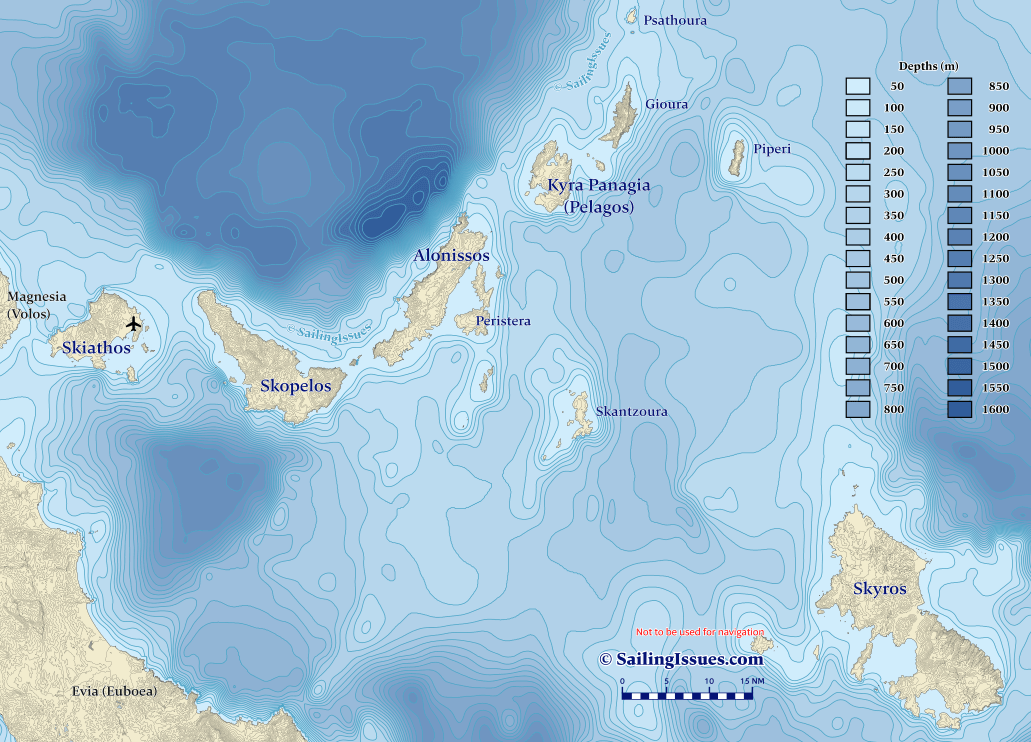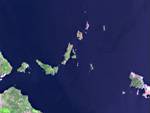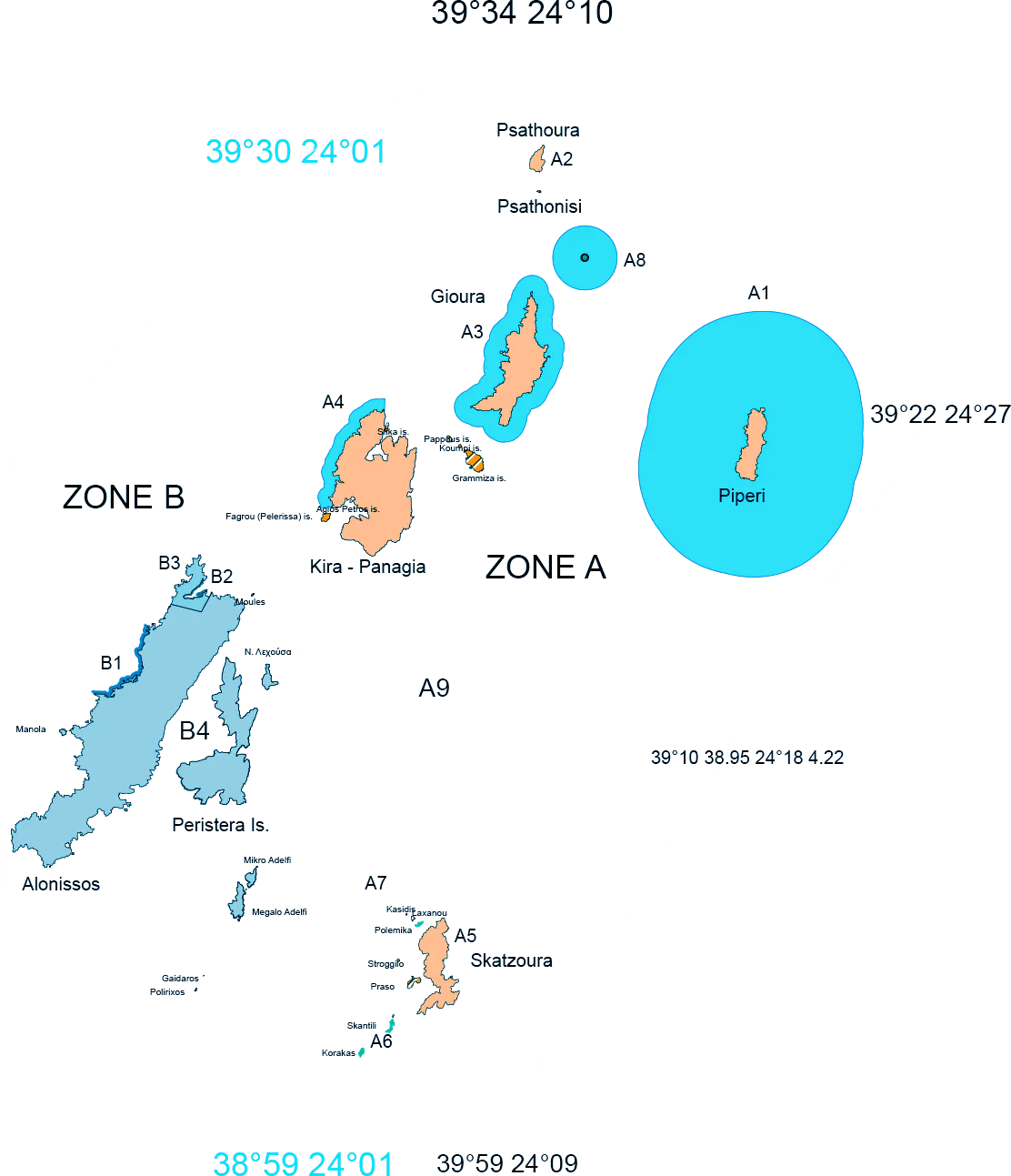Northern Sporades sailing
The Northern Sporades - Βόρειες Σποράδες is the proper name for what people usually call the Sporades, and consist of the fertile islands of Skiathos, Skopelos, Alonissos, Skyros, Pelagos (Kyra Panagia) and the uninhabited Peristera, Skantzoura, Yioura, Piperi and Psathoura. These are all remote and scattered islands, hence “sporadic”, a term that since antiquity referred to island groups outside the Cyclades.

Correspondingly, the lesser sailed Eastern Sporades refer to the cruising area that includes the islands of Lesbos, Lemnos and Chios, which string along the Turkish coastline.
The bigger islands in the Northern Sporades sustain small populations – mostly of craftsmen, farmers and fishermen – and the only proper towns double as ports: Skiathos town, Skopelos town, Patitiri on Alonissos and Linaria on Skyros.
Moreover, on Skopelos island the port of Glossa • Loutraki and on Alonissos island Steni Vala port are also well worth visiting, especially to look for good tavernas in the typically narrow winding streets. But also near the popular beaches on Skiathos and Skopelos you will find lots of tourists in the season, yet as a rule the tavernas and bars tend to be twice as expensive and half as good as in the traditional places.
Interestingly, five or six beaches on Skiathos and Skopelos are considered the best in the eastern Mediterranean and near the ports these beaches can be crowded, however if you have your own yacht there are an abundance of stunning bays to drop anchor where you will be all by yourself. In fact the Northern Sporades are as famous for the beautiful scenery and beaches as for the amount of secluded anchorages and wildlife, hence ideal for yacht charter holidays. For this sailing area the ultimate charter base is the marina in Skiathos port, which even seems to have its own airstrip (planes landing will nearly touch your mast).
The islands of the Northern Sporades

The charts should not be used for navigational purposes.
National Marine Park of Alonnisos
The National Marine Park of Alonissos in the Northern Sporades (NMPANS) measures 2,260 km² and was – much too late – set aside in 1992 by the Greeks for the protection of the unique ecosystem and, particularly, the Mediterranean Monk Seal (Monachus monachus), which symbolizes the Park's identity.
Species sighted in this area include dolphins and whales like the common dolphin Delphinus delphis, striped dolphins Stenella coerruleoalba and the long finned pilot whale Globicephala melas. Making their ponderous way towards distant nesting sites are also Loggerhead turtles Caretta caretta. The seabed harbours extensive Posidonia sea grass meadows, various species of sponge and also the endangered red coral Coralium rubrum. Among the numerous bird species finding refuge in the Park is the cliff-nesting Eleonora's falcon Falco eleonorae and the red- black- and yellow-billed Audouin's gull, one of the rarest gulls in the world. Endangered wildflowers, some endemic to these islands, also take advantage of the absence of human footprints.
Tickets
As of 2022 it has become compulsory to purchase an (online) ticket if you wish to enter the waters of Zone A of the National Marine Park.
Prices:
- per vessel (with or without anchoring): €33.50 per day / night
- per guest on board: €5.50 per day / night
Thus, if you spend a typical three days in the park's Zone A with a party of 6, this will be a 6 × 3 × 5.5 + 3 x 33.5 = €199.5, which is still very affordable compared to e.g. three days at the zoo.
Zone A & B
The Marine Park is divided in two zones:
- Zone A consists of Pelagos (Kyra Panagia), Gioura, Piperi, Psathoura and Skantzoura, and several smaller islets as well as the surrounding waters.
- Zone B includes the only inhabited island of the NMPANS, Alonnissos (Alonisos, Allonisos), several smaller islands and the marine area around them. Apart from regulations on special fishing techniques, most activities are permitted in this zone.

Mind that regulations for the areas A6, A7 and B2, B3 are practically inconsequential for yachtspersons.
Aside from the sea area, the Marine Park includes the island of Alonissos, six smaller islands (Peristera, Kyra Panagia, Psathoura, Piperi, Skantzoura and Gioura), as well as 22 uninhabited islets, rocky outcrops and reefs.
Table of allowed / prohibited activities vs park zones
| Area | Sailing | Anchoring | Swimming | Free diving | Fishing | Night Anchoring |
|
|---|---|---|---|---|---|---|---|
| A1 | Terrestrial area of Piperi island + marine zone upto 3 NM |
||||||
| A2 | Terrestrial area of Psathoura island | ||||||
| A3 | Terrestrial area of Gioura island + marine zone upto 0.5 NM |
||||||
| A4 | Terrestrial area of Kyra Panagia island + marine zone from Pelerissa to cape Katergo for upto ⅓ NM |
||||||
| A8 | Marine zone of 1 NM radius around the reef of Gioura (centre on 39°26'.717 – 024°12'600) |
||||||
| A9 | The remainder of Zone A | ||||||
| B1 | The marine zone between Alonissos' capes Kalamos and Ammoni upto 200 m |
||||||
| B4 | The remainder of Zone B |
Further specifics of allowed / prohibited activities
A2 – Anchoring only in the South bay (Mandraki) of Psathoura island
Fishing is prohibited only upto 1.5 NM away from the coasts
Disembarkation is only allowed in the South bay and its use within a radius of 50 m
A4 – Anchoring only in the bays of Planitis, Monasteri and Agios Petros of Kyra Panagia island
Anchoring at night only in the bays of Planitis and Ag. Petros
Disembarkation is allowed only in the bay of Monasteri
A5 – Anchoring only in the bay of Limani of Skantzoura island
Disembarkation is only allowed in the bay of Limani
Architecture in the Northern Sporades
Except for Skyros – where the Cycladic influences with cubed white-washed houses is clearly visible – the Northern Sporades boast quite a different architecture.
Especially in Skopelos the building style, which is so typical of Macedonia and the adjacent mainland, has left its mark. The houses – all having in common their verandas, balconies and courtyards full of flowers – are surrounded by narrow stone built alleys and whitewashed climbing steps. Due to earthquakes and some degree of neglect the old Venetian houses are rare.
Skiathos likewise doesn't follow the functional and traditional Cycladic building techniques. Skiathian houses are traditionally divided in a ground floor used for storage and middle and upper floors for residence. Unfortunately, few of these houses have survived, but for newer buildings the traditional ceramic tiled roofs, multi-coloured shutters and small balconies are still used, and blend in perfectly with the existing town's atmosphere.
Pilot guides and nautical charts
British Admiralty Charts 1062 and 1571


